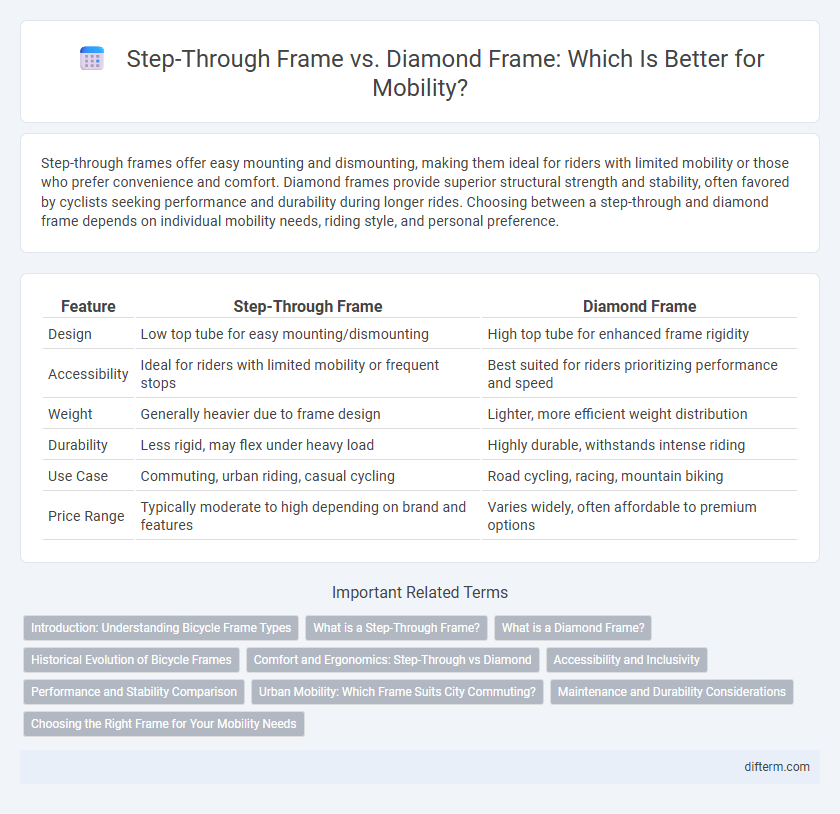Step-through frames offer easy mounting and dismounting, making them ideal for riders with limited mobility or those who prefer convenience and comfort. Diamond frames provide superior structural strength and stability, often favored by cyclists seeking performance and durability during longer rides. Choosing between a step-through and diamond frame depends on individual mobility needs, riding style, and personal preference.
Table of Comparison
| Feature | Step-Through Frame | Diamond Frame |
|---|---|---|
| Design | Low top tube for easy mounting/dismounting | High top tube for enhanced frame rigidity |
| Accessibility | Ideal for riders with limited mobility or frequent stops | Best suited for riders prioritizing performance and speed |
| Weight | Generally heavier due to frame design | Lighter, more efficient weight distribution |
| Durability | Less rigid, may flex under heavy load | Highly durable, withstands intense riding |
| Use Case | Commuting, urban riding, casual cycling | Road cycling, racing, mountain biking |
| Price Range | Typically moderate to high depending on brand and features | Varies widely, often affordable to premium options |
Introduction: Understanding Bicycle Frame Types
Step-through frames feature a low top tube, allowing riders to easily mount and dismount, making them ideal for urban commuting and casual cycling. Diamond frames consist of two triangles formed by the top tube, down tube, seat tube, and chainstays, offering superior strength and efficiency favored in performance and mountain bikes. Choosing between step-through and diamond frames depends on factors like rider comfort, intended use, and bike handling preferences.
What is a Step-Through Frame?
A step-through frame is a bicycle design characterized by a low or absent top tube, allowing riders to easily mount and dismount without lifting their leg high over the frame. This frame style enhances accessibility and comfort, especially for urban commuting and casual riding. Compared to the diamond frame, step-through frames provide greater convenience for individuals wearing skirts, carrying loads, or experiencing limited mobility.
What is a Diamond Frame?
A diamond frame is the most common bicycle frame design, characterized by two triangles formed by the top tube, down tube, seat tube, and chainstays, providing optimal strength and stiffness. Its geometry offers efficient power transfer and superior handling, making it ideal for road, mountain, and commuter bikes. The diamond frame's durability and versatile design contribute to its widespread use in mobility solutions worldwide.
Historical Evolution of Bicycle Frames
The historical evolution of bicycle frames reveals that step-through frames originated in the late 19th century, designed primarily for ease of mounting and dismounting, especially for women wearing skirts. Diamond frames, characterized by their triangular structure, became prominent due to their superior strength and efficiency, dominating competitive cycling and general-purpose bicycles. Over time, innovations in materials and design have blurred the distinctions, but both frame types remain integral to diverse mobility needs.
Comfort and Ergonomics: Step-Through vs Diamond
Step-through frames offer enhanced comfort and ergonomics by allowing easy mounting and dismounting, ideal for riders with limited mobility or frequent stops. Diamond frames provide a more rigid structure that supports optimal body positioning for efficient pedaling and long-distance comfort. Ergonomically, step-through designs reduce strain on the back and hips, while diamond frames promote a forward-leaning posture beneficial for power and endurance.
Accessibility and Inclusivity
Step-through frames enhance accessibility by allowing riders to mount and dismount with ease, accommodating diverse mobility levels and clothing styles, which promotes inclusivity for elderly and disabled cyclists. Diamond frames, while traditionally offering greater structural strength and efficiency, can present challenges for riders with limited flexibility or balance. The increased accessibility of step-through frames positions them as a preferred choice for inclusive urban mobility solutions.
Performance and Stability Comparison
Step-through frames offer easier mounting and dismounting, ideal for urban mobility but generally provide less lateral stiffness compared to diamond frames, affecting high-speed stability. Diamond frames, with a triangular geometry, deliver superior performance through enhanced rigidity and efficient power transfer, making them preferred for competitive cycling and rough terrains. Stability in diamond frames is heightened by a lower center of gravity and better weight distribution, optimizing control during dynamic riding conditions.
Urban Mobility: Which Frame Suits City Commuting?
The step-through frame offers enhanced accessibility and ease of mounting, ideal for frequent stops and casual city rides in urban mobility. The diamond frame provides superior structural strength and efficiency, preferred for longer commutes and higher-speed cycling in congested city environments. Choosing between these frames depends on the rider's priorities for convenience versus performance in city commuting.
Maintenance and Durability Considerations
Step-through frames offer easier maintenance due to their open design, allowing quick access to components like the chain and brakes, which reduces service time. Diamond frames provide superior durability because of their rigid triangular structure, distributing stress evenly and enhancing frame longevity under heavy use. Regular inspection of welds and joints is crucial for both frames to prevent fatigue and ensure safe, long-lasting mobility.
Choosing the Right Frame for Your Mobility Needs
Step-through frames provide easy mounting and dismounting, ideal for riders with limited mobility or frequent stops, enhancing comfort and accessibility. Diamond frames offer superior rigidity and efficiency, suited for long-distance cycling and those prioritizing performance and stability. Selecting the right frame depends on balancing ease of use with riding requirements, ensuring optimal mobility support.
step-through frame vs diamond frame Infographic

 difterm.com
difterm.com